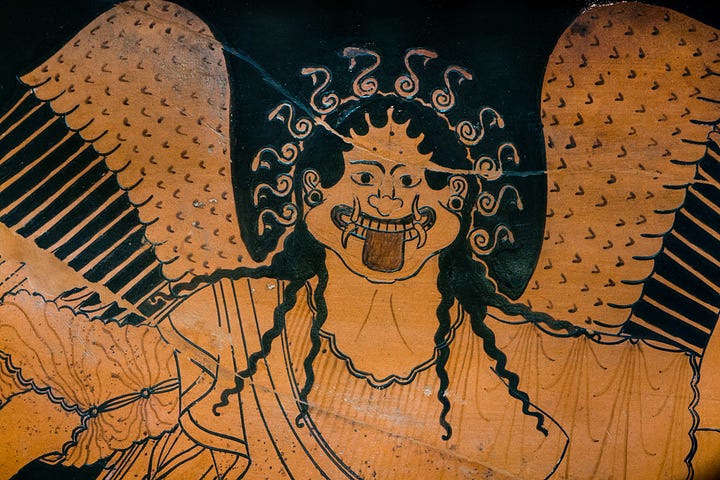
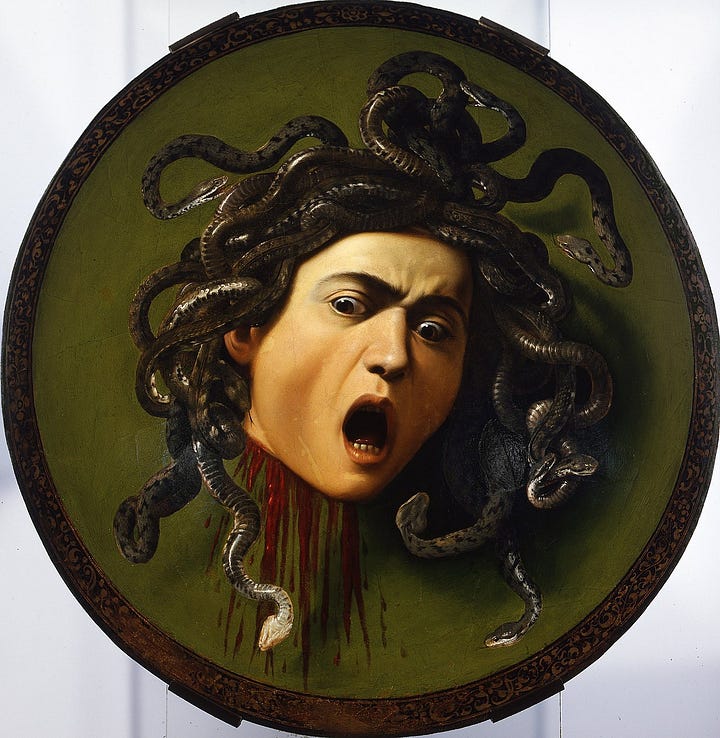
This has been a heavily-requested topic and I have been biding my time because I knew I was hosting an event all about this gorgeous gorgon so I wanted to wait until after to fling my thoughts at you.
The one and only Liv Albert, host of the absurdly popular podcast Let’s Talk About Myths, Baby! very kindly indulged/trusted me when she came to London and I insisted on hosting an event with her. Much like Ann, Holly, and Honor last month, Liv signed on to be part of my ongoing campaign to host in-person events that bring history to life in a way that is ACTUALLY fun/sexy/interesting (as opposed to those events where you’re counting down the minutes until you can leave or check your phone without being rude).
The event was wonderful, Liv’s fans were so thrilled to see her and hear her talk and The Common Press was the perfect venue which I very much plan to use again (I’m tossing around the idea of a Minotaur-specific evening, let me know if you think that’s too niche or just niche ENOUGH).






If you have any interest in listening to Liv and I bang on about Medusa for about an hour, we were fortunate enough to actually record the event so you can tune in over on YouTube:
I’m going to pull some points from the talk itself and flesh them out a bit but I must warn you, we’re going niche with it. Another reason why I hesitated when it came to dedicating a whole newsletter to Medusa was because it seemed so obvious. I struggled to find a fresh angle that actually interested me. Also, the more I write here on Substack, the more I’ve realised that google is free!!! If you wanted a summary of who/what Medusa is or was or a general biography I’m sure you would’ve hit up Encyclopaedia Britannica (or ChatGPT) by now. BUT after researching in the lead up to the event and listening to Liv’s insightful/detailed commentary on the night, I’m ready to get into it. There’s actually a whole bunch going on in Medusa’s mythology that I hadn’t previously considered. As always, if there’s something I’ve missed for the love of god let me know, but without any further ado, let’s dive in.
HER APOTROPAIC FUNCTION
Firstly, you may be wondering what the hell apotropaic means. I’M SO GLAD YOU ASKED. Apotropaic is a word that gets thrown around a lot when it comes to classical art, it is used to describe a symbol or piece of art that offers spiritual protection/wards off evil, kinda like the evil eye 🧿
Other examples of apotropaic art in ancient Greece include snakes 🐍 (they were associated with the Underworld and symbolised renewal) and herms (odd rectangular sculptures with penises sticking out of them 🍆 I wrote a newsletter a million years ago titled ‘what the heck is a herm’ if you’re curious). The most famous example, however, is the head of Medusa. Gorgoneia (the plural of gorgoneion, which just means the head of a gorgon) were found ALL over the place ~ on the bottom of drinking cups, the outside of buildings, even on ancient ARMOUR. The story goes that after Perseus beheads her and uses her decapitated head to turn a whole bunch of people to stone, Athena takes her head and whacks it on her shield to terrify her enemies in battle.

This shield or breastplate was known as her aegis, but using Medusa’s head on armour was not restricted to divinities.


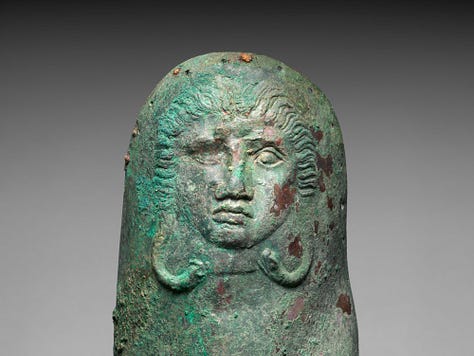
E.g. this gorgeous shin guard that currently lives at the Met.
And a slightly more modern version courtesy of Gladiator 2 (my para-social infatuation with Pedro Pascal reached new, dizzying heights upon seeing this photo).
All that to say, it is quite cool and weird that the Greeks thought they could co-opt the terrifying power of the gorgon head for their own protective purposes.
THE BIRTH OF PEGASUS AND CHRYSAOR
It’s actually crazy to me that we don’t talk about this more because it is a truly ABSURD detail when it comes to the mythology of Medusa. When she is beheaded by Perseus, she somehow gives birth via her decapitated neck?? To two creatures, one being the famous winged horse Pegasus, and the other is Chrysaor, a giant with a gold sword who doesn’t really come up again.
I took a photo of this sculpture at the Museo Archeologico Regionale Antonio Salinas in Palermo because I was THRILLED to see some art that actually depicted this moment ~ here you can see Perseus beheading Medusa as she holds baby Pegasus!
While this is a very cool/super weird aspect of the myth, it is a little bit depressing that even while a female monster is being decapitated it is still somehow about her biological, procreative capabilities.
IS ATHENA TRANSFORMING MEDUSA INTO A SNAKE-HAIRED GORGON ACTUALLY FEMINIST?
No. No it’s not. I don’t know what started this collective delusion. There’s a tiny part of me that wishes I could buy into it, the idea that Athena transformed her so she would never be attacked again. If you’ve been reading these newsletters for a while I’m sure you’ve gathered I’d never be the person to poke holes in modern re-interpretations ~ the gorgeous thing about mythology is that it evolves and means different things to different people over time. And that is lovely. BUT GODDAMN IT I AM MAKING AN EXCEPTION FOR THIS TAKE BECAUSE ATHENA IS LITERALLY THE ONE WHO HELPS PERSEUS BEHEAD MEDUSA. I mean come ON. I’m also not a fan of this interpretation because it seems to disregard the tragedy of Medusa’s story. Ovid’s version states that she is attacked by Poseidon in Athena’s temple and turned into a monster by the goddess for desecrating her temple. It’s a horrible, heartbreaking myth so I get why you’d want to look for a silver lining but I’m afraid I just don’t see one.
Also, Athena is a far cry from a girl’s girl.
She is born from the head of Zeus (after Zeus swallowed her mother, Metis) so technically she doesn’t have a mother.
When Orestes is on trial for murdering his mother Clytemnestra, Apollo argues that the woman was just a vessel therefore not a true parent (as opposed to the man who plants the seed or whatever) so what Orestes did isn’t that big a deal and Athena voted in agreement.1
What she does to Medusa is not even a one time thing! Athena challenges the slightly-hubristic Arachne to a weaving competition, Athena weaves a tapestry showing the gods being divine/majestic but Arachne weaves images of the gods as animals assaulting mortal women. Athena is so enraged by Arachne’s skill and the rather humiliating picture she painted of the gods, she beat her up!! Arachne promptly hung herself and then Athena turned her into a spider??? So she would have to hang from a chord forever??? (And yes, this is where the word arachnid comes from 🕸️).
If I’ve burst your bubble I am sorry but this interpretation just makes my blood BOIL. Also I’m really not a fan of Athena (if that wasn’t glaringly obvious).
BERNINI’S MEDUSA
Now let me offer you a pretty sculpture as a palate cleanser.
I don’t have much to say about this one, I just want you to look at her.
The Laugh of the Medusa, an essay by Hélène Cixous
This essay, published by French feminist critic Cixous in 1975, was originally written in French as "Le Rire de la Méduse," and is all about women reclaiming their creative power, especially when it comes to writing. It’s a cool, somewhat loopy essay with two killer quotes I want to share with you (I’ve included a link at the end if you want to read the whole thing).
“You only have to look at the Medusa straight on to see her. And she’s deadly. She’s beautiful and she’s laughing.”
I love this line and she is presumably referring to depictions like this:
I’m obsessed with her fangs, the detail of her eyelashes, and her GRIN. I think Cixous gives us a way of reclaiming Medusa as a powerful, positive symbol that doesn’t rewrite her transformation at the hands of Athena as some sort of feminist victory.
“Where is the ebullient, infinite woman who, immersed as she was in her naiveté, kept in the dark about herself, led into self-disdain by the great arm of parental-conjugal phallocentrism, hasn’t been ashamed of her strength? Who, surprised and horrified by the fantastic tumult of her drives… hasn’t accused herself of being a monster?”
I have nothing to add to that spectacular excerpt other than my own question, what does Medusa mean to you?
References
If you want to look at Athena/Medusa with a poofy bob:
sanantonio.emuseum.com/objects/5292/columnkrater-mixing-bowl-with-athena
Or that hydria with the EYELASHES:
www.britishmuseum.org/collection/object/G_1867-0508-1048
Or Cixous’ essay:
Cixous, Hélène, Keith Cohen, and Paula Cohen. “The Laugh of the Medusa.” Signs 1, no. 4 (1976): 875–93. www.jstor.org/stable/3173239
"The mother is no parent of that which is called her child, but only the nurse of the new-planted seed that grows. The parent is he who mounts." Aeschylus, Eumenides, lines 658–666.


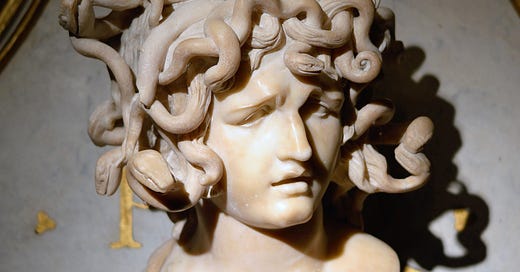







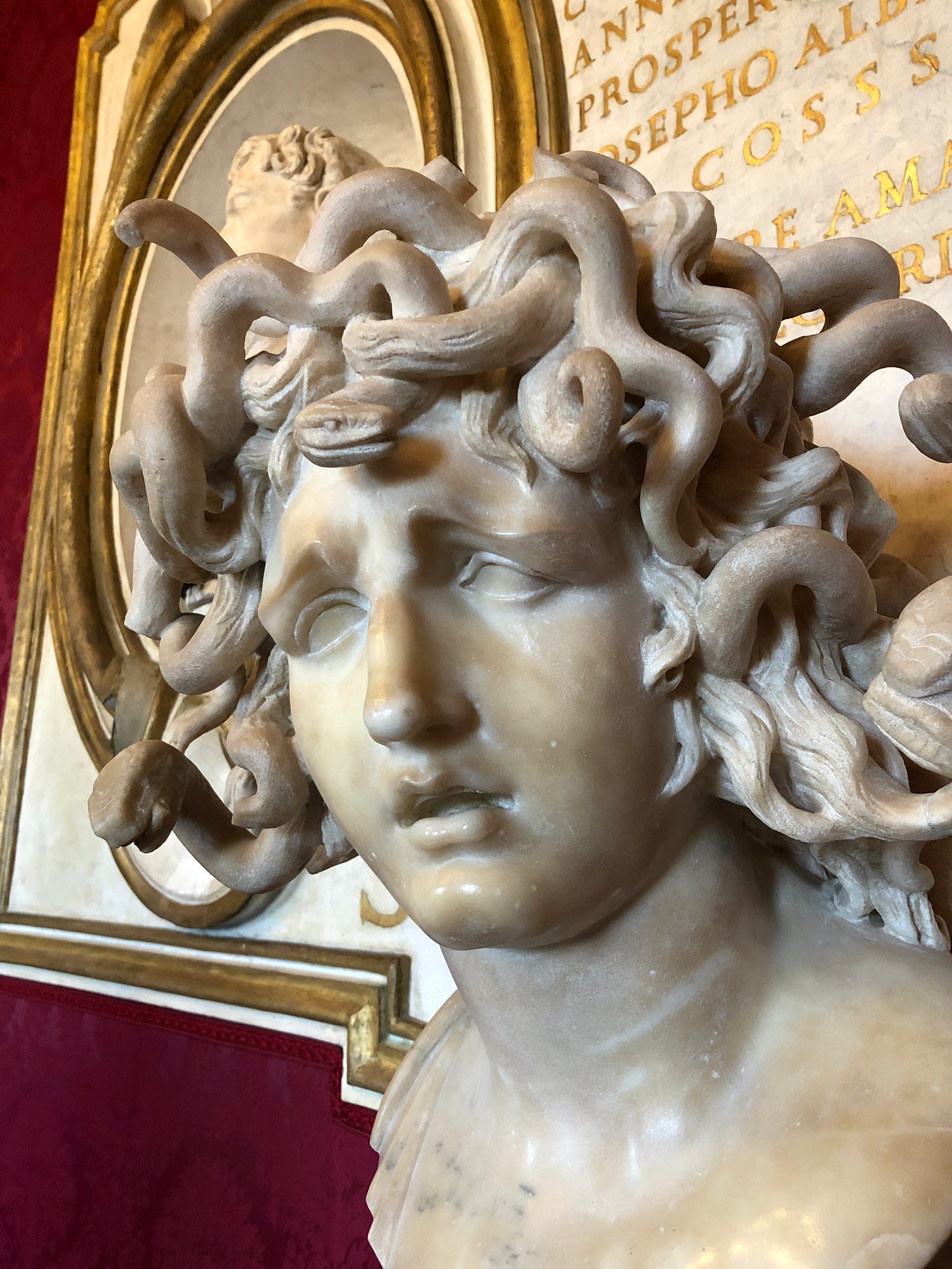

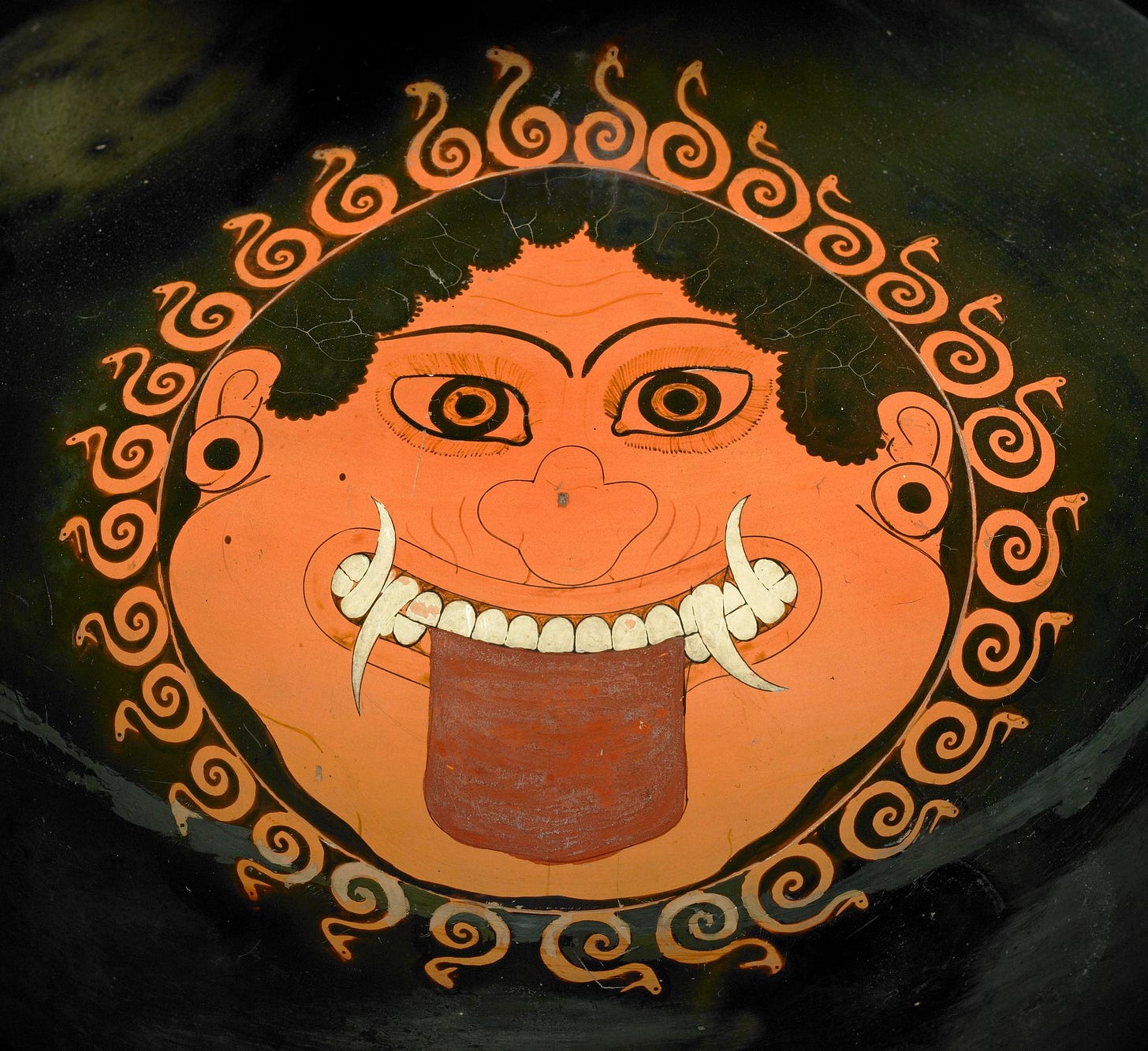
It was painfully clear who was really at fault
When Lot’s Wife was turned into a pillar of salt.
But can Gorgon Medusa be plausibly blamed
If some powerful goddess had wanted her framed?
It’s Promachos I mean. She is brilliant, but callous.
Born from Zeus’ split head, glowing warrior, Pallas.
For in dealing with mortals, no goddess is meaner
Than the Virgin of Victory,
Grey-eyed Athena.
Poor Medusa was raped on a Parthenon’s stairs, by Earth Shaker, Poseidon (before the snake hair).
So Athena should fault the sea god with the Trident,
But she fears Zeus’ brother
And dares not be strident.
Athena’s bold protégé, Perseus by name,
By beheading Medusa, Bellerophon came.
And the sire of Pegasus, yclept Pelagios?
Athena keeps Uncle Poseidon quite close.
Apó ti vóreia chora,
Glenn
Thank you, thank you, thank you for this. Natalie Haynes opened my eyes to the real Medusa tragedy and I cannot bear to read anything that denies her innocence and the evil of Athena and Perseus (not a hero). I was worried when I started reading you might be one of ‘those’ - still intoxicated by the vile exploits of Perseus and the ongoing destruction by Athena - she is the mythic equivalent of Margaret Thatcher. Wouldn’t be surprised if MT has a secret tattoo of her!